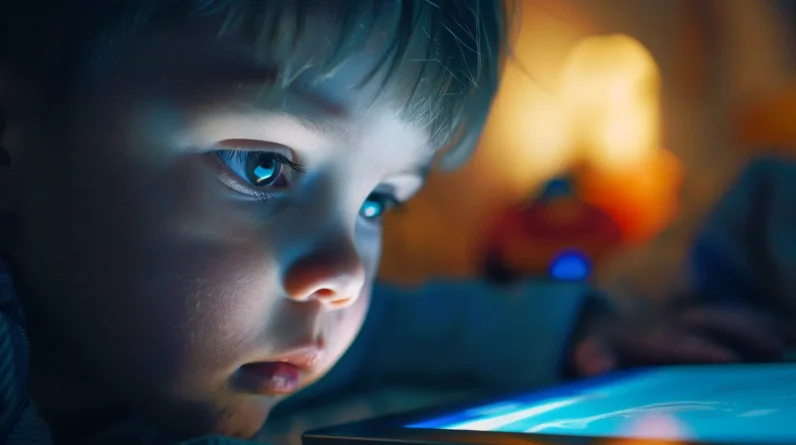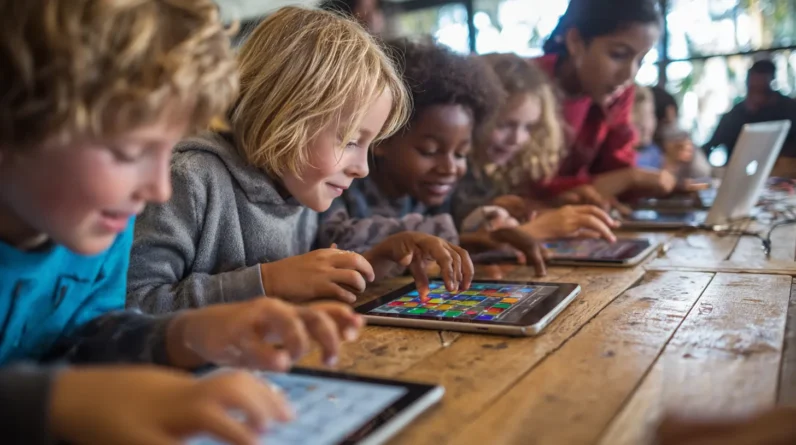
Smart devices aren’t just entertainment for kids—they’re actively reshaping how children see themselves through dopamine-driven reward systems. We’re seeing children tie their self-worth to social media metrics like likes and followers, while gaming achievements create narrow definitions of success. Since developing brains crave these digital dopamine hits and can’t fully regulate until the mid-twenties, kids become vulnerable to validation cycles that replace real-world confidence building. Understanding these neurological patterns helps us guide children toward meaningful digital engagement that supports healthy identity formation.
The Neuroscience Behind Digital Rewards and Developing Brains
When children interact with smartphones, tablets, and gaming devices, their developing brains respond differently than adult brains do to the same digital stimuli. We’re witnessing unprecedented changes in how young minds process rewards and form neural pathways. During critical brain development phases, dopamine surges from digital interactions create stronger imprints than they would in mature brains. Children’s prefrontal cortex—responsible for impulse control and decision-making—won’t fully develop until their mid-twenties, making them particularly vulnerable to digital reward cycles.
We must understand that repeated exposure to instant gratification affects how kids view themselves and their capabilities. When digital detachment becomes difficult, it’s not simply poor self-control—it’s neurobiology. The developing brain craves these dopamine hits, potentially reshaping how children measure their worth and seek validation from both digital and real-world experiences.
Social Media Validation and Its Impact on Children’s Self-Worth
This neurological foundation sets the stage for understanding how children navigate social media’s complex validation systems. We’re witnessing unprecedented social pressures as kids curate online personas that often disconnect from their authentic selves. Children’s developing brains interpret likes, comments, and shares as social currency, directly linking external validation to self-worth. When posts receive minimal engagement, kids experience genuine distress—their dopamine-driven reward systems interpret this as social rejection.
We’ve observed how children increasingly measure their value through metrics: follower counts, story views, and comment ratios become barometers of social standing. This constant performance creates exhausting cycles where kids feel pressured to maintain carefully crafted images. The gap between their real experiences and online personas widens, potentially undermining genuine self-acceptance and authentic relationship-building skills.
Gaming Achievement Systems and Identity Formation
While social media validation creates external pressure through peer comparison, gaming achievement systems operate differently by building internal reward structures that can fundamentally reshape how children view success and failure. We’re witnessing how these digital frameworks influence identity formation during critical developmental years.
Gaming platforms create powerful psychological cycles that affect children’s self-perception:
- Instant gratification loops replace natural learning patience with expectation of immediate rewards
- Achievement hierarchies establish narrow definitions of worth based on points, levels, and rankings
- Virtual reality experiences blur boundaries between digital accomplishments and real-world value
- Persistent progression systems maintain engagement through fear of falling behind peers
Understanding these mechanisms helps us guide children toward healthy digital citizenship. We must recognize that gaming achievements, while potentially motivating, shouldn’t become primary sources of self-worth or identity validation.
Screen Time Versus Meaningful Digital Engagement
Beyond the familiar debates about screen time limits lies a more nuanced conversation about digital engagement quality that directly impacts children’s development. We’re discovering that meaningful digital experiences—creating content, solving problems collaboratively, or learning new skills—foster positive self-concept differently than passive consumption. When children engage purposefully with technology, they develop digital citizenship skills while building confidence in their abilities.
The key isn’t eliminating screens but ensuring parental guidance shapes how children interact with them. We can help kids distinguish between mindless scrolling and intentional use by modeling thoughtful engagement ourselves. Research shows children who participate in structured digital activities demonstrate improved self-efficacy and identity formation compared to those with unlimited, unguided access. Quality trumps quantity in digital development.
Warning Signs of Problematic Device Dependency in Children
Subtle behavioral shifts often signal when a child’s relationship with devices has crossed from healthy engagement into dependency territory. We need to recognize these red flags before they escalate into more serious concerns affecting our children’s self-worth and development.
Key warning signs include:
- Emotional dysregulation when digital boundaries are enforced or devices are removed
- Sleep disruption from late-night usage or anxiety when separated from technology
- Social withdrawal from family activities or face-to-face peer interactions
- Academic decline coupled with secretive device usage patterns
These behaviors indicate that parental involvement must increase immediately. When children exhibit multiple warning signs simultaneously, their device relationship has likely shifted from tool usage to emotional crutch. Early intervention through consistent boundaries and open communication prevents dependency from undermining healthy development.
Building Healthy Digital Habits That Support Positive Self-Image
Recognizing these warning signs empowers us to take proactive steps that reshape our children’s digital experiences. We must establish clear boundaries around screen time while modeling healthy device usage ourselves. Digital Literacy becomes vital—teaching children to critically evaluate online content, understand algorithmic manipulation, and recognize how social media affects their emotions. Parental Guidance involves creating device-free zones during meals and before bedtime, encouraging face-to-face interactions, and celebrating offline achievements equally with digital ones. We can implement co-viewing practices, discussing what children encounter online and helping them process these experiences. By fostering real-world connections, encouraging creative pursuits beyond screens, and maintaining open dialogue about digital challenges, we guide our children toward technology use that enhances rather than undermines their developing sense of self.
Conclusion
We can’t put the digital genie back in the bottle, but we can guide our children toward healthier relationships with technology. By understanding how devices affect developing brains and self-worth, we’re better equipped to foster meaningful engagement over mindless consumption. When we model balanced digital habits and prioritize real-world connections, we help our kids build resilience and authentic self-image. The goal isn’t elimination—it’s intentional use that supports their growth and well-being.







